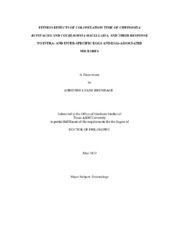| dc.description.abstract | Chrysomya rufifacies and Cochliomyia macellaria are two medically and forensically important necrophagous flies that dominate ephemeral resources in the southern US. Since its introduction in 1981, Ch. rufifacies has become established throughout the New World due to its larvae being facultative predators. Through this research I examined the interaction between the native, primary colonizer C. macellaria and the invasive, secondary colonizer Ch. rufifacies and elucidated the olfactory mechanisms used to locate, colonize, and exploit ephemeral resources. This work used competition experiments, olfactometer experiments, and high-throughput sequencing to investigate the effects of priority colonization of ephemeral resources on both species, the olfactory mechanisms employed by gravid females to locate a resource, and the effects of egg-associated volatiles on those females.
Results from competition experiments indicated that priority sequence significantly affected the fitness of both C. macellaria and Ch. rufifacies. Regulation of colonization time is not chiefly governed by resource age, as previously thought, but is affected by colonization of the resource by conspecific and heterospecific individuals. Colonizing adults may use cues from early colonizers to assess resource quality. These cues may be derived from the physiology of the eggs, the 31-39 species of bacteria I determined are present on the egg chorion, or some combination of both. Design of these experiments facilitated the development of techniques to surface-sterilize Calliphoridae eggs, analyze behavior of adults in a dual choice olfactometer, and associate adult response to conspecific and heterospecific eggs with environmental cues that ultimately affect larval fitness. | en |


